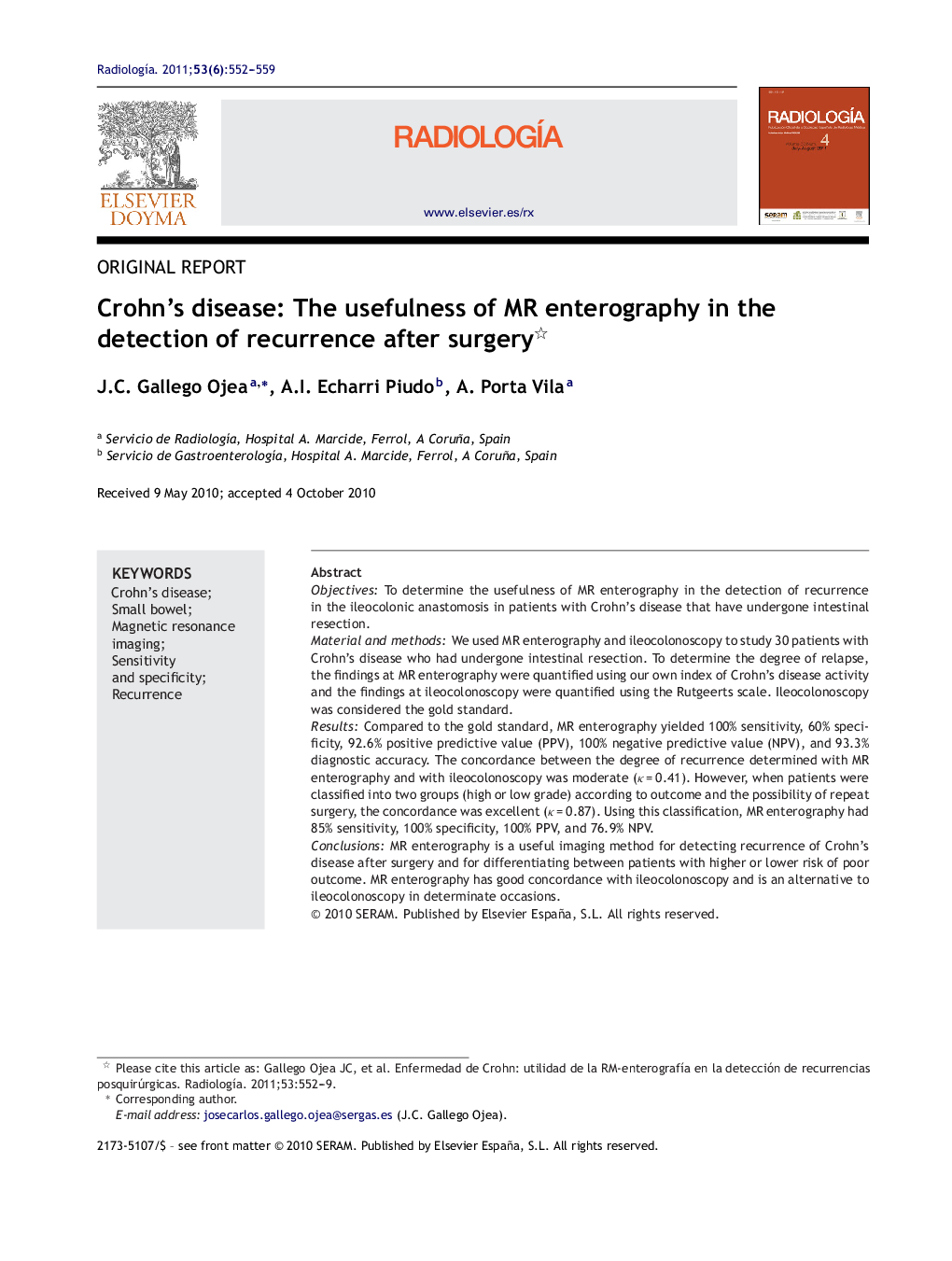| کد مقاله | کد نشریه | سال انتشار | مقاله انگلیسی | نسخه تمام متن |
|---|---|---|---|---|
| 4246604 | 1283584 | 2011 | 8 صفحه PDF | دانلود رایگان |

ObjectivesTo determine the usefulness of MR enterography in the detection of recurrence in the ileocolonic anastomosis in patients with Crohn's disease that have undergone intestinal resection.Material and methodsWe used MR enterography and ileocolonoscopy to study 30 patients with Crohn's disease who had undergone intestinal resection. To determine the degree of relapse, the findings at MR enterography were quantified using our own index of Crohn's disease activity and the findings at ileocolonoscopy were quantified using the Rutgeerts scale. Ileocolonoscopy was considered the gold standard.ResultsCompared to the gold standard, MR enterography yielded 100% sensitivity, 60% specificity, 92.6% positive predictive value (PPV), 100% negative predictive value (NPV), and 93.3% diagnostic accuracy. The concordance between the degree of recurrence determined with MR enterography and with ileocolonoscopy was moderate (κ = 0.41). However, when patients were classified into two groups (high or low grade) according to outcome and the possibility of repeat surgery, the concordance was excellent (κ = 0.87). Using this classification, MR enterography had 85% sensitivity, 100% specificity, 100% PPV, and 76.9% NPV.ConclusionsMR enterography is a useful imaging method for detecting recurrence of Crohn's disease after surgery and for differentiating between patients with higher or lower risk of poor outcome. MR enterography has good concordance with ileocolonoscopy and is an alternative to ileocolonoscopy in determinate occasions.
ResumenObjetivosDemostrar la utilidad de la RM-enterografía (RM-E) en la detección de recurrencias en la anastomosis ileocolónica en pacientes con enfermedad de Crohn (EC) que han sufrido una resección intestinal previa.Material y métodosSe estudió a 30 pacientes con EC e historia de resección intestinal mediante RM-E e ileocolonoscopia. Para determinar el grado de la recurrencia, los hallazgos se cuantificaron mediante un índice propio de actividad de la EC en RM y mediante el índice endoscópico de recurrencia de Rutgeerts, respectivamente. Se consideró a la ileocolonoscopia como el patrón de referencia.ResultadosLa RM-E mostró para la detección de recurrencia sensibilidad del 100%, especificidad del 60%, valor predictivo positivo (VPP) del 92,6%, valor predictivo negativo (VPN) del 100% y exactitud diagnóstica del 93,3%. La concordancia entre el grado de la recurrencia determinado por RM-E y por ileocolonoscopia fue moderada (κ = 0,41). Sin embargo, después de establecer solo dos grupos (alto o bajo grado) que indican el comportamiento evolutivo y la posibilidad de nueva cirugía, la concordancia pasó a ser excelente (κ = 0,87). Para este supuesto se obtuvo sensibilidad del 85%, especificidad del 100%, VPP del 100% y VPN del 76,9%.ConclusionesLa RM-E es un método de imagen útil para detectar la recurrencia posquirúrgica en la EC y diferenciar entre grupos de mayor o menor riesgo evolutivo. Su concordancia con la ileocolonoscopia es alta, por lo que puede ser una alternativa en determinadas ocasiones.
Journal: Radiología (English Edition) - Volume 53, Issue 6, November–December 2011, Pages 552–559